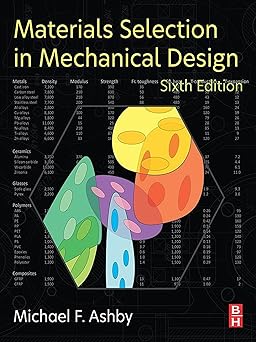Key Highlights
- •Features the definitive Ashby methodology for systematic material selection.
- •Includes comprehensive, updated material property charts (Ashby charts).
- •Essential 6th Edition resource for mechanical design students and professionals.
Description
Struggling to pick the right material for your mechanical designs? Unlock the secrets with Materials Selection in Mechanical Design, 6th Edition by the legendary Michael F. Ashby! This isnt just another textbook; it's your essential guide to making smarter, more effective material choices in engineering.
Who is this book for? It’s perfect for mechanical engineering student, practicing design engineers, materials scientists, and anyone involved in product development who needs to understand why one material work better than another. If you're facing the daunting task of sifting through thousands of materials, this book provide a clear path.
What problem does this book solve? It tackles the core challenge of materials selection head-on. Forget guesswork! Ashby presents his world-famous methodology, using clear explanations and powerful visual tools like the Ashby charts, to help you systematically select materials based on function, constraints, and objectives. It help you balance performance, cost, and even environmental impact.
What will you gain from reading it? You'll learn a robust, logical process for material selection that you can apply to any design problem. Understand the vast landscape of engineering materials – metals, ceramics, polymers, composites – and their key properties. Gain the ability to justify your material choices with confidence. This 6th edition is fully updated with the latest data and insights, making it incredibly relevant for todays design challenges.
Why is it worth reading? Michael Ashby is a giant in the field, and this book is considered the standard reference. It combine rigorous theory with practical application, making complex concepts accesible. Getting this knowledge right can be the difference between a successful product and a costly failure. Dont miss out on this foundational resource. Download the PDF now and elevate your design skills!
FAQ
Is this book good for undergraduate students just starting with materials science?
Absolutly! While comprehensive, Ashby explains concepts clearly. It's a standard text in many undergrad courses, laying a strong foundation for **material selection**. Some parts might be challenging, but the core methods are presented step-by-step.
Does the book explain how to use the Ashby charts?
Yes, definitely! A major part of the book is dedicated to explaining the **Ashby methodology**, which heavily relies on these unique material property charts. It shows you exactly how to interpret and use them for selection.
What kind of materials are covered? Metals, plastics, composites?
It covers the full spectrum of engineering materials: metals, polymers, ceramics, composites, and even natural materials. The focus is on the *selection process* applicable across all these classes.
What's the main difference between this 6th edition and previous ones?
The 6th edition features updated material data, including new information on sustainable materials and **eco-design** considerations. It refines the examples and ensures the content reflects current engineering practices.
Is this book more theoretical or practical for a working engineer?
It strikes a great balance. It presents the underlying theory of **materials science** but focuses heavily on the practical application of the selection methodology in real-world **mechanical design**. Many engineers keep it as a desk reference.
I need this for a project. How quickly can I get the PDF after purchase?
Typically, the PDF download link is provided almost imediatly after purchase confirmation, often via email. Check the specific seller's delivery details for exact times.
Reader Reviews
About the Author
Michael F. Ashby is Emeritus Professor of Engineering at the University of Cambridge and a leading international authority on materials science and engineering design. He is renowned for developing the 'Ashby charts,' innovative graphical tools for material selection used worldwide by educators, students, and engineers. His work has profoundly influenced how materials are taught and selected in mechanical design, making complex choices more systematic and accessible.
